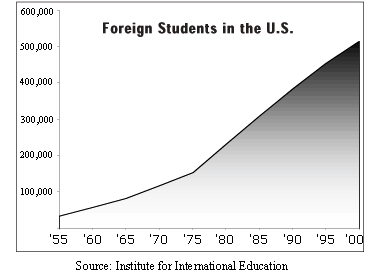
| ISSUE PAPERS |
HOME PAGE About Us Get Involved Membership Research Legislation Newsroom |


At any point, there are roughly 500,000 foreign students in American colleges and universities. The rate of increase in the foreign student population outstrips that of native students. While the number of American undergraduates increased 40 percent over the last 20 years, the number of foreign undergraduates increased 200 percent. As a result of the influx of foreign students, our graduate schools are producing a glut of science Ph.D.s (about 22 percent more than needed); more than half of those Ph.D.s are foreign students. Most of the increase in Ph.D.s is due to foreign graduates, an estimated 50 percent of whom fail to return to their home countries. By flooding the job market, they depress salary levels, which dissuades American students from entering the sciences. Such foreign graduate students are particularly attractive to universities when they can use them to meet affirmative action goals, which were designed to help American native minorities.
“Some foreign governments ask foreign students specifically to acquire information on a variety of technical subjects and upon the completion of their studies, some foreign students are then encouraged to seek employment with U.S. firms to steal proprietary information.”
FBI Director Louis Freeh, testimony before Congress.
“We know for a fact that organizations funded by a state sponsor of terrorism fund students coming to the United States. And that is part of their intelligence organization.”
Deputy FBI Director Dale Watson, testimony before Congress.
“As an estimated half million foreign college students started their classes this fall, a significant loophole in the U.S. immigration and national security policy allowed students from state-sponsors of terrorism in the Middle East to enter the United States to study subjects that could enhance their countries’ chemical, biological, and nuclear weapons programs. In 1991, U.S. weapons inspectors in Iraq discovered documents detailing a purposeful Iraqi government strategy to send its students abroad, most importantly to the United States, specifically to study nuclear-related subjects in order to develop Iraq’s non-conventional weapons programs. One of these students received his doctorate in nuclear engineering and then returned to Iraq to head its nuclear weapons program. Thousands of students from the five countries the State Department has designated as sponsors of terrorism (Iran, Iraq, Libya, Sudan and Syria) are still studying in the United States, mostly in science-related fields and some apparently with financing from their governments. Over the past five years, nearly 10,000 students from these countries were issued visas to study in the U.S.”
Hillary Mann, Open Admissions:U.S.Policy Towards Students from Terrorism-Supporting Countries in the Middle East, Washington Institute for Near East Policy, 1997.
According to the National Center for Education Statistics, 59 percent of all foreign graduate students receive financial aid, and 40 percent receive direct grants as opposed to loans which must be repaid.
In October 1997, the federal government joined a lawsuit filed against Georgia’s Brewton-Parker College for defrauding financial aid programs for ten years by awarding grants to foreign students who didn’t qualify and for disbursing federal money for American students to foreign students instead. In June 1998, a congressional investigation began of six University of California campuses that defrauded the government of $100 million by improperly billing it for tuition waivers given to foreign graduate students. “Why should taxes paid by U.S. workers be used to enlist foreign nationals into Ph.D. programs at America’s leading research university system?” the lawsuit asked. “U.C. uses taxpayer-funded federal research and development awards to give stipends and tuition aid to foreign students who will take the cutting-edge knowledge instead of providing this knowledge to American students.”
In 1996, over half the Iranian students in the U.S. were enrolled in science, math, or engineering programs, and U.S.-trained scientists have been reported working on Iraq’s nuclear and biological weapons programs, as well as India’s. Members of the terrorist network that destroyed the World Trade Center also used our lax F1 visa program to get into the U.S. without ever even taking a class.
Moderating the surge in foreign student enrollment could be accomplished in several ways. It could be done with an annual ceiling, like for immigration. Or it could be done through more careful visa issuance screening to deny visas to a larger share of those unlikely to return home. Another approach would be to condition the student visa so that the student would not be eligible to remain in the U.S. at the end of his or her studies nor eligible to take a job. This provision applies now to exchange visitors (“J” visas), people who come usually for research or in university exchange programs. They are required to depart the U.S. and remain abroad for at least two years before seeking to return to take a job.
Modified 10/02